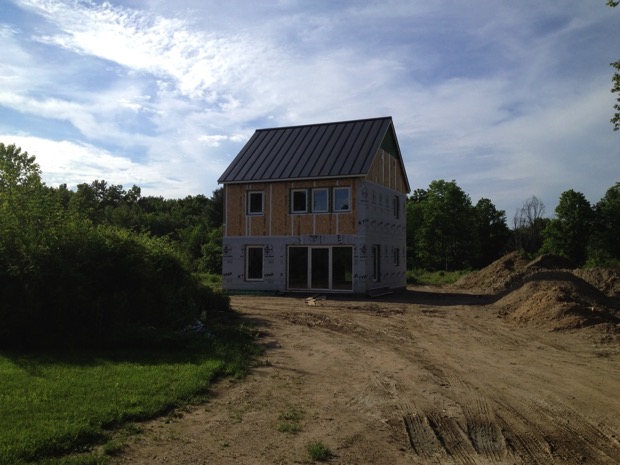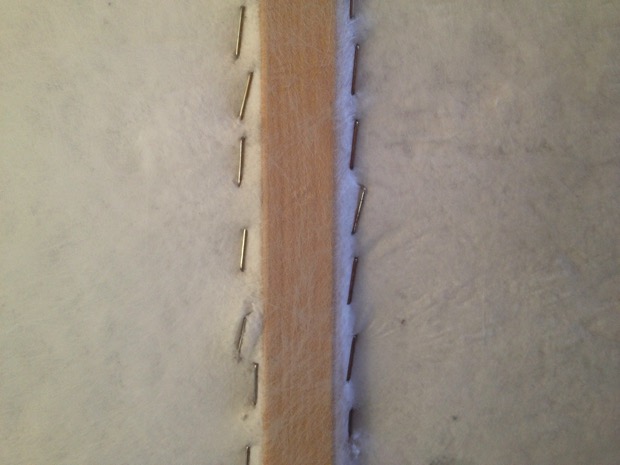
In keeping with Mount Holyoke College’s Sustainability Initiative, our final projects in Phys/Envst 104 this year focussed on raising awareness about planning for energy self-sufficiency in order to enable the college to disconnect from the electricity grid.
Why are we thinking about going off-grid when most people are just now hearing about the whole net zero concept? Consider that within five years, battery and solar costs will have fallen to such an extent that going off-grid will be cheaper and more reliable than staying on the grid. There is a real possibility of a utility death spiral that will threaten the reliability of the grid for everyone. Now is the time for us to begin planning for energy self-sufficiency, especially as extreme weather, intermittent renewables, and grid hackers increasingly challenge the integrity of the grid. Download these eleven high resolution Factsheets and learn what you need to know to help take Mount Holyoke College off the grid!
Burning money: the consequences of heat loss
When people arrive at Mount Holyoke College they immediately remark upon the beautiful old buildings surrounding Skinner Green. The aging structures are even more apparent to the students who live in them, for they are constantly reminded of the thin walls and drafty windows. The buildings clearly lack sufficient thermal insulation, the most important aspect of energy conservation. Thermal insulation plays an important role in energy conservation, as the majority of energy waste is found in heat loss. Through insulation, unwanted heat loss or gain can be significantly reduced in a building. Wall material must have low thermal conductivity to create a “building envelope” and trap the temperature inside. Mount Holyoke College, established in 1837, is located in South Hadley, Massachusetts and has 40 major buildings which make up over two million square feet of property. Much of the campus is heated by natural gas purchased from Direct Energy, which is delivered to a Central Plant by Columbia Gas through their piping system. The college spends $1,186,396 on natural gas to heat the campus each year.
There’s a great future in storage
How would you like to spend your winters studying by candlelight in a cold and dark library? Well, this will be your future unless a proper system of energy storage is implemented. Imagine a day when we finally transition to renewable energy sources at Mount Holyoke College, yet we have no way to store it. In the summer solar panels will bring in all of the energy you could ask for and more, but come winter when the sun is scarce, generating sufficient energy will be a challenge. Next, imagine a scenario where there was a methane leak from natural gas storage and we were confronted with a full-fledged power outage on campus. These situations could be avoided if we implemented an effective storage method.
The Prospect Hall Greenhouse: a sustainable makeover for underutilized space
Download PDF
With Super Blanch close to completion, Mount Holyoke is facing a lack of creativity in implementing initiatives to utilize large indoor spaces where dining halls currently are. To combat the loss of on-campus work-study dining staff jobs, and to put these gutted spaces to use in a green campus initiative, we propose that the Prospect Dining Hall be repurposed into an indoor greenhouse. Maintaining this space will resolve the issue of work-study job loss. Building the greenhouse and community surrounding it will be a job for Residential Life staff, using this space to generate conversation and student activism in an already-enthused group of residents. By combining sustainability, aesthetic appeal, and educational value, Mount Holyoke College will create a space which will improve the quality of life of students, faculty, and staff.
Solar energy

Download PDF
As fossil fuel resources continuously deplete and exacerbate the environment, alternative modes of energy are becoming increasingly necessary. As the most abundant renewable resource, solar has the capability to harness the sun’s energy into a variety of uses, such as heating water and generating electricity. All of the Five-College campuses have already implemented solar energy except Mount Holyoke. A proposed solar system for the roof of Kendall Gym has a total size of 627.2 kW DC generating 749,613 kWh AC annually, an output which the College can utilize fully. Mount Holyoke College will thus save over $86,000 in utility costs in Year 1 and offset over 955,000 lbs. of greenhouse gas emissions annually. This factsheet introduces the potential of solar energy, the technology, as well as how it is conducive to saving funds on energy usage as electricity costs rise.
Sustainability is a breeze with wind energy

Download PDF
Our current myopic reliance on fossil fuels has poisoned the planet with Carbon Dioxide. Humanity has reached a point where making dramatic changes is a literal matter of life or death. The Earth cannot sustain our lifestyles without the use of renewable energy. Although solar energy is commonly viewed as the most viable renewable energy option for homeowners and commercial buildings, wind is a plentiful resource that has been widely overlooked and that can supplement solar energy. Whereas fossil fuels are not only a depreciating investment that requires continued labor resources while polluting the air and damaging the landscape, wind turbines function without maintenance and can be installed wherever there is ample space and Class 3 winds, or wind that has an average annual speed of 14.3 to 15.7 mph at 50m. A 2015 study by the U.S. Department of Energy found that wind could provide 20% of U.S. electricity by 2030 and 35% by 2050 if implemented properly. Wind energy will be a significant force in the responsible energy system of the future. Where does wind fit into Mount Holyoke college’s plan for a sustainable future? Wind provides energy during the winter when MHC solar panels cannot access enough strong light. This saves on battery costs because solar energy does not need to be stored for the winter while wind energy is generated spontaneously. Wind turbines can also be placed on flat, vacant rooftops that are not compatible with solar panels.
Get more use less: how to improve Creighton

Is your building LEED Certified? Does it still consume a ton of energy throughout the day? Would you like to decrease the energy use, yet increase the comfort levels? If you answered yes to one or more of these questions, Passive House is right for you! Passivhaus is a building movement first developed in Germany aiming to reduce the ecological footprint of buildings. It is a standard for energy efficiency, creating buildings that require little energy for heating or cooling, through several strategies dealing with ventilation and thermal envelopes.
Education to avoid the apocalypse: it’s never too late

Do you know your chances of survival by the time you’re 50? We really need this knowledge for which we urgently need a conference similar to the BOOM conference held earlier this semester. The panels and events will be based around the topics outlined in this fact sheet. Both students and faculty would be invited to present or facilitate panels and discussion. The topics that would be covered should be important and relevant to helping Mount Holyoke students become climate literate. Climate change impacts everyone , no matter what they’re studying, and a conference could be instrumental in increasing climate literacy on campus. Because Mount Holyoke is a diverse and inclusive space, putting an emphasis on the make up of industries that will be responsible for helping to fight these issues with renewable goods and technologies is important. As a community with students from 45 states and 75 countries1 we need to address the ways people in different regions will be affected by climate change differently, and this also serves to help students learn about the regions they may be focusing on in their time here. Fighting climate change requires knowledge of the opposing factors, such as the petroleum industry, and the financial and political ways real change can be hampered. Overall this conference should give students the knowledge and tools they need to be changemakers, no matter what they’re studying, and impart a sense of urgency in finding and fighting for solutions to the problems facing our world.
Be accountable for your energy consumption

Download PDF
Mount Holyoke College is filled with passionate and intelligent students that are concerned about the environment, begging the Administration to stop the madness and be a leader in the fight for divestment from fossil fuels. But, are students aware of their own wasteful and unnecessary energy consumption in their living spaces? As we turn on two different lamps at a time for a “cozy” study space and leave our laptops and phones charging overnight, we are neglecting our own responsibility for the ways in which Mount Holyoke can become a more efficient campus. In order for students to reduce their energy consumption, their wastefulness needs to be placed somewhere that cannot be ignored. It is the responsibility of Mount Holyoke College, as a private institution, to align their goals with state regulations. The call to action has passed; now we are simply behind.
Biting down on climate change

Download PDF
Meat, particularly red meat, is one of the most environmentally costly consumption choices available. At Mt. Holyoke College in 2016, 41.7% of responding students identified as non omnivorous consumers, making MHC students some of the most environmentally conscious consumers in America! However, the dining options on campus don’t always match the dietary demands of the student body. If students took the initiative to push for less red meat in the new centralized dining area, it could astronomically lower the ecological footprint of the college! Take a look at the numbers!
Cultivating the future of Mount Holyoke

Download PDF
The dining halls on campus are spaces that every student at Mount Holyoke experiences frequently. But how many of the students who frequent these dining halls stop and think critically about where the food that they consume comes from? It just magically appears to be prepared by the lovely dining staff for us to enjoy, right? The truth is that a large percentage of our food comes from commercial farms across the country, which means that a great amount of energy is put into bringing that sprig of parsley to MHC so that the chefs can add flavor to those potatoes from Idaho. Commercial farming does not concern itself with the quality of food or the long term impact on the environment that it has. By moving towards growing food on campus and educating the students about the processes involved in regenerative farming, Mount Holyoke could begin to create that lasting change that we claim not to fear.
Secrets your architecture firm won’t tell you: retrofit Prospect

Download PDF
Rather than building a new facility, retrofitting existing buildings provides a more feasible, cost-effective option to update the energy performance of building assets for their ongoing life. Retrofit involves the modifications of existing buildings that will allow the opportunity to improve multiple design objectives such as energy efficiency, energy demand, occupant health, and indoor environmental quality. Furthermore, retrofits will reduce the operational costs, particularly in older buildings. In the heart of Western Massachusetts' Pioneer Valley with a castle-like Mary Lyon Hall and Hogwarts-looking library, Mount Holyoke College attracts students from all races and ethnic groups throughout the world. Along with the beauty of the campus, the palatial dorms are a big reason as to why students are drawn to Mount Holyoke. One dorm in particular, however, does not blend in with the rest. Built in 1959, Prospect Hall desperately needs to be renovated, or in other words, retrofitted.



















































